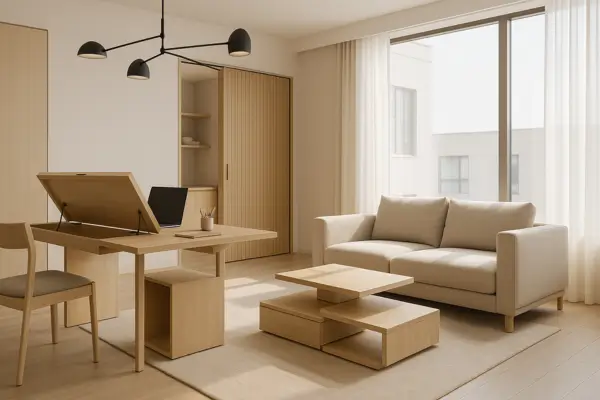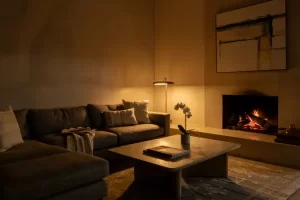Interior design is no longer static. In today’s spaces, furniture and decor aren’t just meant to fill a room—they’re expected to respond, adapt, and engage. This is where kinetic and modular design step in. These elements bring a dynamic quality to interiors, allowing pieces to shift, rotate, expand, or reconfigure depending on need or mood. “Design that moves” embraces functionality without sacrificing beauty, creating homes that feel alive, interactive, and deeply personal. In this article, we’ll explore how kinetic and modular furnishings add energy, versatility, and style to modern interiors—and how you can use them to breathe new life into your home.
What Is Kinetic and Modular Design?
Kinetic design refers to objects that move or transform. This can mean anything from a table that expands, a chair that rocks, or lighting that adjusts directionally. Modular design, on the other hand, is about flexibility—furniture made of independent units that can be reconfigured or combined to suit changing needs. Both styles share a common goal: to make interiors more interactive, adaptive, and emotionally engaging. Instead of fixed forms, these designs celebrate movement, transformation, and freedom of arrangement.
The Appeal of Motion in Design
Movement naturally draws the eye. A chair that sways, a wall panel that slides, or a rotating bookshelf adds a sense of life and curiosity. Kinetic elements reflect the human desire for change and rhythm—they prevent a space from feeling frozen. Even the smallest motion, like a light fixture with adjustable arms or a mobile sculpture, can transform the energy of a room. This kind of design connects with people not just functionally, but emotionally.
Benefits of Modular Furniture in Daily Living
Modular pieces are designed to adapt. Whether you’re furnishing a studio apartment or a flexible family home, modular furniture offers the freedom to adjust layouts as your lifestyle changes. Some of the main benefits include:
- Customizable Layouts: Rearrange modules to create new configurations depending on function or mood.
- Space Efficiency: Ideal for small homes where every square meter matters. Combine, stack, or store elements with ease.
- Multi-purpose Use: A modular sofa can double as a guest bed. A shelf unit can split into side tables. Flexibility is built in.
- Longevity: Instead of replacing an entire piece, add or remove modules to extend usefulness over time.
Beyond function, modular furniture also brings a unique visual harmony to interiors—especially those rooted in minimalist design. Its aesthetic qualities deserve just as much attention as its adaptability.
Modular Aesthetics and Minimalist Appeal
Modular furniture often fits seamlessly into minimalist and modern interiors. Clean lines, geometric forms, and neutral palettes allow the pieces to blend into a space quietly—until you need them to change. Then, the transformation becomes part of the room’s narrative. This subtle functionality keeps visual clutter at bay while enhancing user experience.
How Kinetic Pieces Add Emotion and Energy
Kinetic furniture introduces interaction. Rocking chairs, pivoting lamps, sliding partitions—each invites movement and engagement. These elements reflect our human need for touch, rhythm, and play. A mobile piece can also serve as a focal point or conversation starter. For example, a hanging kinetic sculpture in the living room may sway gently with the breeze, adding both motion and tranquility.
Movement That Connects People to Space
Unlike static furniture, kinetic pieces foster a deeper connection between user and space. When a table extends to welcome guests, or a lamp adjusts to your reading posture, the design feels personal. It adapts to your presence, creating a sense of partnership rather than passivity. This emotional dynamic is what turns “decor” into “experience.”
Smart Design for Evolving Spaces
Our homes are more than static containers—they evolve as we do. The ability to shift furniture, create zones, and reshape rooms on demand supports modern lifestyles. Modular and kinetic design aligns perfectly with small apartments, growing families, hybrid workspaces, and renters who need adaptability without permanence. In a single afternoon, a room can shift from lounge to office to yoga studio—thanks to smart, moving design.
Examples of Transformative Design
Some of the most compelling interiors today feature pieces that shift shape or function at the user’s command. Think of:
- Expandable dining tables: Compact daily use, expandable for entertaining.
- Wall-mounted desks: Fold away when not needed, opening up floor space.
- Sliding partitions: Divide or open rooms depending on activity or time of day.
- Stackable seating: Use one, or build out a whole lounge area on demand.
- Mobile lighting: Lamps with arms that pivot or rotate to redirect ambiance as needed.
As these examples show, movement within design isn’t just functional—it’s expressive. When applied with intention, it allows your space to adapt fluidly to your lifestyle while enhancing both comfort and beauty.
Design Harmony: Blending Motion with Style
Integrating moving pieces doesn’t mean sacrificing cohesion or elegance. The key is thoughtful placement and a consistent aesthetic. Choose kinetic or modular items that match your room’s material palette—wood, metal, fabric—and respect your layout flow. Movement should feel intuitive, not chaotic. The goal is a sense of ease: objects that respond naturally and feel like an extension of your daily rhythm.
Pairing with Static Elements
Balance is essential. Too much motion can create restlessness. Combine kinetic features with grounding, stable pieces—such as a heavy coffee table or fixed cabinetry—to anchor the space visually. This contrast makes movement more intentional and meaningful, rather than distracting.
Emotional Design: Movement That Resonates
Movement speaks to the body and the mind. It engages our senses, reminds us of nature, and reflects our inner rhythm. Just as a rocking chair soothes or a folding screen invites privacy, kinetic and modular elements connect people to their homes in active, personal ways. This emotional connection increases satisfaction, usability, and long-term appreciation of the space.
Why People Feel Better in Spaces That Move
Static environments can feel oppressive or uninspiring. When your space moves with you—adjusting to tasks, moods, or even seasons—it becomes a partner rather than a backdrop. This flexibility supports well-being, productivity, and joy in the everyday. You feel seen, supported, and in control of your environment.
Modular and Kinetic Design in Different Styles
While modular and kinetic designs often appear in modern or minimalist spaces, they are incredibly versatile and can adapt to any interior style. For instance, rustic spaces can benefit from sliding barn-style doors or extendable wooden tables. Boho or eclectic interiors can include layered, movable seating or stacked poufs. Even classical spaces can incorporate kinetic chandeliers or rotating bookcases for a touch of drama and flexibility.
Sustainable Advantages of Moving Design
One of the hidden strengths of kinetic and modular design is its alignment with sustainability. Rather than replacing furniture as needs change, users can modify, expand, or adapt their existing pieces. This reduces waste and increases longevity. Many modular brands also use eco-friendly materials and sustainable production methods, making them an excellent choice for environmentally conscious design.
Conclusion
Design that moves is design that lives. It’s about interaction, evolution, and personalization. Whether through modular furniture that grows with your needs or kinetic elements that add rhythm and beauty, moving pieces create homes that respond.
They don’t just fill space—they participate in it. They listen, adapt, and shift with you. This kind of design transforms interiors from fixed arrangements into fluid environments that support your lifestyle, your mood, and your vision for the future.
Incorporating motion into your space isn’t just a practical solution—it’s an emotional investment. It brings joy, curiosity, and freedom into everyday living. In a world that changes constantly, your home can become a space that flows with you—one flexible, intentional, and expressive design choice at a time.




